
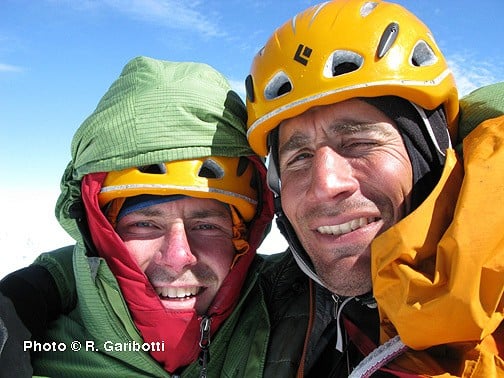
About Rolando Garibotti
Rolando Garibotti was born in Italy, brought up in Argentina and now lives in Boulder, Colorado. He has visited the Fitz Roy and Cerro Torre massif well over a dozen times, climbing his first Patagonian peak at the age of fifteen. His fluency in the Italian language was the key that enabled him to uncover the lie at the heart of Cesare Maestri's claim to have made the first ascent of Cerro Torre. His full article was published in the 2004 American Alpine Journal. Garibotti added further weight to his argument against Maestri by making the long awaited first ascent of the claimed line in 2006, giving El Arca de los Vientos. He has made other significant ascents in this area including the first complete ascent of Tehuelche on the north face of Fitz Roy in 1996 and the second ascent of the Slovak Route on Fitz Roy's southwest face in 1999.
Download the PDF of Rolando's full Cerro Torre Article from the American Alpine Club website.
About Colin Haley
Colin Haley is a twenty two year old student at the university of Washington and is no stranger to hard climbing. Notable ascents include the first linkup of the Marsigny-Parkin and West Face on Cerro Torre in a 48-hr push, the first winter ascent of Mount Huntington (Alaskan winter climbing is a gnarly business) and the first ascent of House-Haley (VI, WI5, M7) on the Emperor Face, Mt. Robson, British Columbia.
About Ermanno Salvaterra
Ermano Salvaterra was born in 1955 in the village of Pinzolo, Dolomites. He began climbing in the Dolomites at the age of nine, and made an ascent of the Torri d'Agola aged eleven. A qualified ski instructor and mountain guide, Salvaterra has made over twenty two expeditions to Patagonia since his first trip there in 1982. He has climbed Cerro Torre, Fitz Roy, the Aiguille Guillaumet and the Poincenot amongst other peaks in the area. He also made the first winter ascent of Cerro Torre with Maurizio Giarolli, Andrea Sarchi and Paolo Caruso. It is rumoured that he used to hold the world speed record on skis.
View Ermano's Youtube page with Videos of Patagonia and Cerro Torre
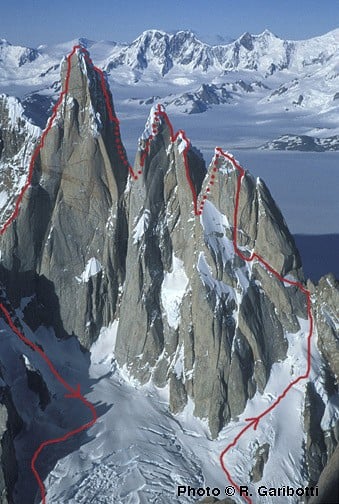
When did you first climb in Patagonia?
At the age of fifteen, as part of a Club Andino Bariloche outing in which nine of us kids spent one month in the area with one adult looking after us. Two of us climbed Guillaumet; myself and my next door neighbour in Bariloche, who was 16 at the time. You couldn't do stuff like that today. Liability and things of that kind would get in the way. I'm glad I got to reap the benefits of a more “innocent” society.
What is it about Patagonia that attracts you?
I have lived in the US for the past fourteen years. Coming to Patagonia is a simple practical solution. I get to see my family, I get to reconnect with my friends and with my culture. It is also quite cheap to go there and since I practice this activity at an amateur level this is basically the only kind of trip I can afford.
And when did you first envisage the Torre Traverse?
After climbing El Arca on the north face of Cerro Torre. It seemed natural that having solved that puzzle we would try the traverse next. Before then I had always thought it was too hard and too low percentage of a project to have any real interest in it.
How many times have you attempted the line? And what stopped you on those previous attempts?
The real attempts were only two, the successful one and one other during which we climbed until half way up the upper portion of Arca (11/07), although there was one other attempt during which we climbed Standhardt (10/06), but that time we knew the weather would not give us a chance at the whole traverse so we climbed mostly for the heck of climbing.
The conditions you encountered didn't sound ideal, is the crux of the traverse finding good conditions and weather? Was your experience vital for the success on the route?
Some good weather is mandatory. This traverse is on exposed ridges which would be quite hard to climb during a bad weather period. We climbed in bad weather the first day, but we knew windless sunny weather was on the way. We have gotten quite good at the weather forecasting thing over the last few years and we have come to trust our evaluations of the weather models quite a bit. Unlike other folks we don't consult any meteorologists, we just look at what is available on the web and make do with that.
As far as conditions go, we climbed it in conditions that I had previously thought would make the traverse unclimbable. Rappeling down Standhardt and looking over to Punta Herron I was quite concerned that we would not find a way to climb past the rime, but using the best of our sense of smell we did.
Obviously the fact that between El Arca and my previous attempt with Hans Johnstone I had done 100% of the traverse was helpful. There were no uncertainties. In that regard it was quite an uninteresting climb. That is why I am not sure if I would rank it amongst the climbs that have rewarded me the most. I felt much more fulfilled after coming down from Fitz Roy's north face in 1996 (first complete ascent of Tehuelche) than after the traverse. I thought about the traverse for two years only, but had Fitz north face in my head for ten years before succeeding.
Have you climbed with Colin Haley previously? His CV is extremely impressive – any thoughts?
Nope, I have never climbed with him, not even one pitch. I knew him from last season, and had spent a bit of time with him here and there, enough to know that we would get along. As far as his skills go - his resume speaks for itself. In spite of his age he was much more than an equal partner. His biggest asset is his head. He was put on this earth to climb. I am sure he will go far, very far. I don't know if there are any other alpinists in North America with the amount of motivation and drive he has.
What was the highlight of the traverse for you?
The last bivouac, sixty meters below the summit of Cerro Torre. The moon was out, big and bright, lighting up the scenery. It felt pretty special to be there.
Was the arrival of the Huber brothers and Stephan Siegriest a motivating factor in starting out on the ridge?
We would have started the same day even if Alex, Thomas and Stephan had not been there. We wanted to get a jump on the weather, to have an extra day on Cerro Torre in case it was needed. When I retreated in November with Hans Johnstone, we did so because we found bad conditions and did not have any spare time to find an alternate route before the next storm arrived. We did not want the same thing to happen again.
Also, I really did not want to be up there with them, because I was afraid that their presence might influence my decision making, turning into a potentially unsafe situation
There was an important difference between them and us, in the sense that I had been waiting for another try since November, so I was perhaps willing to put up with worse conditions just because I had a little higher level of "frustration", which translates into more drive and motivation. This happens to me in many trips. I need to wait till the end, till right before I have to go home to put out my best effort. This very thing happens a lot in football, when often the last few minutes of any game are the most active.
You have said that the only committing lead was the final rime tunnel, however Leo Houlding took a 90 ft fall attempting what was to become your route El Arca de los Vientos – did you climb this pitch on the traverse?
When Leo fell he was trying to free climb. I am a practical climber, more interested in efficiency than anything else. The pitch where Leo fell is not a committing pitch for a climber willing to use a little bit of aid. When I am on Cerro Torre I am all business - climbing as fast as possible with the least amount of risk. Leo in his approach was a little ahead of his time. I am sure sometime in the near future people will succeed on Cerro Torre with a much fairer approach than mine. That might be the next step - two climbers, with no jumars, both free climbing – a Mick Fowleresque type of approach, with some Leo Houlding mixed in.
The most committing pitches of El Arca are up high, in the north face itself, but they are really not bad at all.
What's next for you?
For the last year I have been trying to find different ways in which to help the Los Glaciares National Park, where Fitz Roy and Cerro Torre are located. It is still to be seen whether something positive will come of it or not, but it seems like we are headed in the right direction. Patagonia Inc is helping the American Alpine Club carry some of these ideas forward. Most of my energy next season will be devoted to this. Hopefully I will have some more tangible news regarding this matter in the near future.
I have had some of the greatest experiences of my life in this Park, so it seems only fair that I devote a little time and effort to give back.
What's next for Patagonian climbing?
It seems that there is little hard climbing being done in Patagonia these days, and I include myself in this too. It has been a long time since anyone other than Ermann Salvaterra has done proper hard climbs here. I think Quinque Annni Ad Paradisum on Cerro Torre's East face is one of the best examples of what a difficult climb is, and it was climbed in very good style. Hopefully people will be willing to follow in his footsteps a little more. Our alpinism today is too comfortable. I think the alpinism of the 1980s was far more committed, far more involved. All the Slovene routes from that time have quite hard climbing on them, and they all sit there unrepeated and untried. Climbing those routes in alpine style seems to be an obvious next step.
Clearly the future is not in the use of fixed rope, although certain quarters seem to be quite unwilling to let go of them. Unfortunately there were some good examples of that this year.
Have you noticed any change in climate conditions over your visits to Patagonia? Do you think global warming is having an effect on the mountain routes in that area?
The glaciers are receding at incredible speed, and periods of good weather like the one that happened in January are totally unheard off, so yes, I would say that things are in flux, changing. It is getting drier and warmer. While this might lead eventually to more climbs being done it will also lead to more accidents. Mountains of this kind when they are dry and warm are not very hospitable places. I might continue to come in October and November to find more alpine conditions.
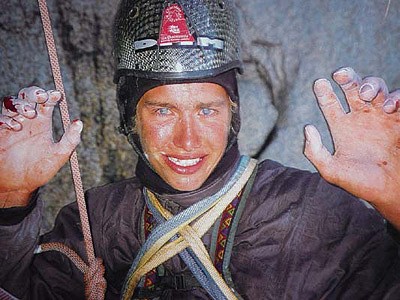
In 1981 Phil Burke and Tom Proctor made an audacious attempt at what was to become El Arca. Proctor and Burke, both excellent climbers, made use of a metal box that had been constructed by the British team of Campell-Kell and Wyvill. The box was a metal portaledge that the teams hauled up behind them on the face. Burke commented about the difficulties they encountered: “The grade would be modern ED3/4, with high standard rock pitches and particularly difficult ice pitches from 70° to overhanging, as well as dry tooling on one pitch, where I fell jumping from a sky-hook for a good hold! The average angle of the wall is more than 70°.”
Arguably one of the most active British ascentionists in Patagonia has been Mike 'Twid' Turner, with his trio of difficult new routes: A Fist Full of Dollars on Curnos Norte in 1991, For a few Dollars More on the Mascara (both with his wife Louise) and The Good, The Bad and the Ugly! 800m A3, 5.10 (not summited) a new line on the un-climbed South face of The South Tower of Paine (with Stuart McAleese).
Leo Houlding and Kevin Thaw attempted what was to become El Arca de los Vientos in 2002. Their attempt ended on the ninth pitch when Houlding fell ninety feet, shattering his foot. He had to crawl several miles to base camp, helped by Thaw.
In 2005 the Plas y Brenin team of Iain Peter, Neil Johnson and Steve Long made an ascent of the Compressor Route on Cerro Torre, but only after a near miss at the final belay when a lump of ice knocked Iain unconcious and also hit a climber on the first all female ascent team from Slovenia. Luckily all teams summited safely.

The Torre Traverse climbs from north to south the skyline comprised by Aguja Standhardt, Punta Herron, Torre Egger and Cerro Torre, with approximately 2200 meters of vertical gain. This traverse is the brainchild of Italians Andrea Sarchi, Maurizio Giarolli, Elio Orlandi and Ermanno Salvaterra, who tried it on several occasions in the late 80s and early 1990s. In 1991 Salvaterra, together with Adriano Cavallaro and Ferruccio Vidi managed to climb to Punta Herron, completing what is likely the first ascent of the peak. Salvaterra climbed Herron via a new route on the north ridge, the aesthetic Spigolo dei Bimbi.
In early 2005, German Thomas Huber, together with the Swiss Andi Schnarf completed the Standhardt to Egger traverse. Having only intended to climb Standhardt via “Festerville,” they decided on the summit to continue on toward Egger, and moving light and fast completed this section of the traverse in 38 hours round trip, and descended via Egger's “Titanic” route on the east ridge.
In late 2005, Salvaterra, together with Alessandro Beltrami and Rolando Garibotti, solved the last remaining puzzle of the traverse when they climbed Cerro Torre from the north via a new route, “Arca de los Vientos.” With a route finally completed from the Col of Conquest to Cerro Torre's summit, Salvaterra returned in 2006 with Beltrami and Garibotti to try the traverse yet again, but bad weather prevented him from getting further than Standhardt.
Unfazed, Salvaterra returned in late 2007 with Beltrami, Mirko Masse and Fabio Salvodei. On this attempt they climbed Standhardt via Salvaterra's own “Otra vez” and continued on to climb Herron and Egger. They descended to the south, to the Col of Conquest, and climbed one pitch on Cerro Torre before retreating. During that same period of good weather, Garibotti, together with Hans Johnstone, began the traverse on Standhardt's “Festerville.” They climbed Herron and Egger, and continued past the Col of Conquest, completing half of the upper portion of Cerro Torre's “el Arca” before being turned back by a rime mushroom.
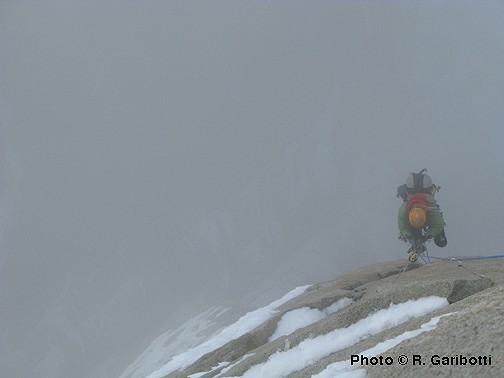
Around mid January 2008 Alex and Thomas Huber, together with Swiss Stephan Siegrist arrived in Chalten, also with hopes of trying the traverse. On January 21st, in less than ideal weather and conditions, Haley and Garibotti began the traverse while the Hubers and Siegrist decided that conditions and weather were not suitable.
Haley and Garibotti climbed Standhardt via “Exocet,” reaching the summit slightly past midday, then rappelled to the Col dei Sogni between Standhardt and Herron. Climbing up “Spigolo dei Bimbi” they found rime covered rock and were forced to climb variations to pitches 2, 3 and 4. Slowed down by the snowy conditions and windy weather they bivied below the Herron mushrooms. On January 22nd, in perfect weather but feeling unusually tired, likely due to carbon monoxide poisoning inside their bivy sack, they continued on over Herron and Egger to reach Cerro Torre. On Egger's north ridge they were also forced to climb some variations to avoid rime covered rock. The good weather brought unusually high temperatures, so upon reaching the Col of Conquest they were forced to find a place to hide from the falling ice, and stopped to bivy at around 5 PM under a prow of rock. The next morning, January 23rd, brought a pleasant surprised when they discovered that the rime mushroom that had stopped Garibotti and Johnstone's attempt two months before, had fallen off. Haley and Garibotti found the upper “Arca” in worse conditions than Garibotti had encountered in 2005, and were forced to clean much ice from the cracks. Garibotti was forced to place one bolt at a crux pendulum to avoid yet another rime mushroom. Tired from the previous two days and slowed down by the conditions they reached the top of Cerro Torre's north face at 5 PM, and here joined the final pitches of the “Ferrari” route on the west ridge. They climbed two pitches through natural rime tunnels to reach the base of the last pitch, notorious for having turned many climbers around. Haley and Garibotti, both of who had led this final pitch before found it in more difficult condition that they had previously seen. This final pitch is climbed by laboriously digging vertical trenches through the rime, and since no other party had yet attempted it this season, they found the 50-meters of protection-less rime daunting. Haley attempted the pitch in the evening, digging 30 feet of half pipe in one hour before giving up for the day. Under a full moon they bivied one pitch below the Torre summit. “Rested” after a long night shivering, Haley attacked the pitch again, digging a tunnel from the top of his half pipe. He spent three hours completing a 20-meter tunnel inside the mushroom, and exited to finish in a naturally formed tunnel.
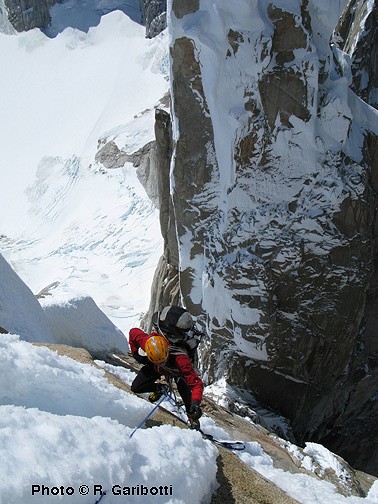
Although success on the Torre Traverse has been elusive because of strategy and weather difficulties Garibotti comments that it involves little extreme climbing, with difficulties never above 5.11 and A1. Other than the last “Ferrari” pitch there are no really committing leads. Garibotti feels that the future of Patagonia alpinism lies not in link-ups or traverses but perhaps in alpine style repeats of the inmense routes of the 1980s, such as Silvo Karo and Janez Jeglic's Cerro Torre South Face or their Devil's Directissima on the East Face. Having felt partly responsible for delaying an academic career, Garibotti was relieved upon returning to their bivouac in the Torre valley to hear Haley exclaim, “The Torre Traverse is way better than mineralogy homework!” A big thanks goes to "il Maestro", to Ermanno Salvaterra, for the idea, for the inspiration, and for continuing, 20 years on, to show the way...
Other Link-Ups in World Mountaineering:
Uber-athlete Ueli Steck, now famous for his record breaking ascent of the Eiger in 2 hours and 47 minutes, made an astonishing link up of the Eiger, Mönch and Jungfrau north faces along with Stephan Siegrist in a little over 24 hours.
Legendary French climber Patrick Berhault was one of the most accomplished mountaineers who pushed the link-up philosophy as far as he could. In 2000 and 2001 he created the ultimate enchainment when he walked, skied and climbed the length of the Alps, from Slovenia to France, between August and February. Berhault was tragically kiled in April 2004 whilst attempting to climb all 82 4000m peaks in the Alps in 82 days.
After the completion of the Torre Traverse, which was considered one of the last great challenges of world mountaineering, thoughts turn to the next level of link ups - moving from Patagonia to the highest mountains of the world. Considered the ultimate link is the Nuptse-Lhotse-Everest traverse, the ridges that form the western comb. The fantasy route takes in the west ridge of Everest, passes the south col, then heads up over Lhotse and over to Nuptse.
I asked Kenton Cool, who has summited Everest five times, whether he considers this a realistic future objective: "You can never say things aren't possible, but I can't see it being done in my life time. It would take a huge amount of logistical support. The amount of time above 8000m is huge, the Nuptse traverse hasn't been done in its entireity and the west ridge has only been climbed once in its true form, but hey - they said Mandela would never go free..."
Read Rolando's account of tackling the infamous 'Ice Mushrooms' in the UKC article Mush - Here










Comments